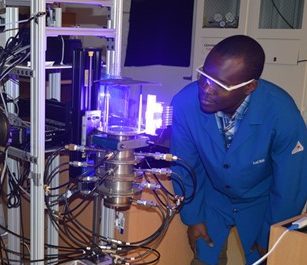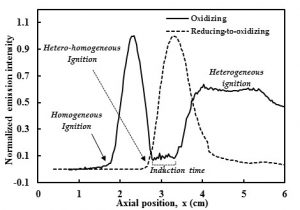
Fundamental experiments on the early stages of coal combustion are important for addressing environmental and human health concerns resulting from combustion-generated aerosols. More specifically, experimental studies of coal particle ignition under conditions relevant to practical pulverized coal burners are important to provide a greater understanding of key issues, such as flame stability, char burnout, efficient heat transfer and in-flame control of combustion-generated aerosols.
 In the Laboratory for Advanced Combustion and Energy Research (LACER), we are at the forefront of providing such information through innovative research. We have developed a novel two-stage Hencken flat-flame burner to understand coal particle ignition and aerosol formation under similar particle heating rates, residence times, gas temperatures and, most importantly, gas compositions. The figure to the left shows the new experimental platform with all the aforementioned characteristics. We use a high-speed camera for high-resolution videography of the coal particles. The technique allows us to track particles, before and after they begin emitting light, and to capture high-resolution images and videos of early-stage processes within the first few milliseconds of combustion.
In the Laboratory for Advanced Combustion and Energy Research (LACER), we are at the forefront of providing such information through innovative research. We have developed a novel two-stage Hencken flat-flame burner to understand coal particle ignition and aerosol formation under similar particle heating rates, residence times, gas temperatures and, most importantly, gas compositions. The figure to the left shows the new experimental platform with all the aforementioned characteristics. We use a high-speed camera for high-resolution videography of the coal particles. The technique allows us to track particles, before and after they begin emitting light, and to capture high-resolution images and videos of early-stage processes within the first few milliseconds of combustion.
 Using this flat-flame burner, we continue to explore in detail, as never before, the process of coal ignition. We evaluate factors that affect pulverized coal – such as particle size, temperature and particle-particle interaction – using the two-stage Hencken flat-flame burner. The results of our research work show the “reducing-to-oxidizing” transition can affect both ignition time delays and the mechanism of ignition. While the homogeneous-to-heterogeneous ignition mechanism occurs in post-flame oxidizing environments, we observe that hetero-homogeneous ignition prevails when the conditions are changed to environments with a reducing-to-oxidizing transition at the same nominal gas temperatures (see figure on right).
Using this flat-flame burner, we continue to explore in detail, as never before, the process of coal ignition. We evaluate factors that affect pulverized coal – such as particle size, temperature and particle-particle interaction – using the two-stage Hencken flat-flame burner. The results of our research work show the “reducing-to-oxidizing” transition can affect both ignition time delays and the mechanism of ignition. While the homogeneous-to-heterogeneous ignition mechanism occurs in post-flame oxidizing environments, we observe that hetero-homogeneous ignition prevails when the conditions are changed to environments with a reducing-to-oxidizing transition at the same nominal gas temperatures (see figure on right).
Fundamental studies, such as this, will inform improved coal burner design and optimization, ultimately driving efficient and cleaner coal use.

